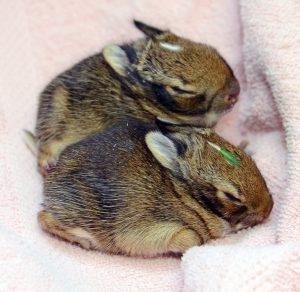What To Do If You Found Sick or Injured Baby Rabbit
About Baby Rabbits

A rabbit who is 4 inches long, hops well and has open eyes and erect ears is independent from its mother and should be allowed to fend for itself. Uninjured baby rabbits in an intact nest should also be left alone. Although they might look abandoned because mom isn’t around, mother rabbits visit their dependent young only a few times a day to avoid attracting predators. Mother rabbits spend more time with the babies from dusk till dawn.
If the nest has been disturbed, lightly cover it with natural materials you find around the nest, like grass, fur or leaves, and follow these steps:
- Keep all pets out of the area.
- Avoid touching the babies.
- Use grass or twigs to make a tic-tac-toe pattern over the nest to assess whether the mother is returning to nurse the young. Check back 24 hours later.
- If the grass or twigs were moved aside but the nest is still covered with fur, grass or leaves, the mother has returned to nurse the babies.
- If the tic-tac-toe pattern remains undisturbed for 24 hours, you should contact a licensed wildlife rehabilitator.
What to Do
Protect Yourself
Wear gloves. When dealing with non-carnivorous mammals, a thick pair of work gloves, a thick jacket, and other personal protection can prevent injury. All mammals can carry the rabies virus. Do not use bare hands when helping mammals. Please be careful not to get bitten, licked, or scratched by the animal as well.
Prepare a Container
Have a sturdy box or animal carrier ready to contain the animal. Garbage cans, recycling bins, and plastic containers will work in a pinch, depending on the size of the animal.
Capturing the Animal
Place a thick towel over the animal and quickly gather it inside the towel. Place the animal immediately in an appropriately-sized box with a secure lid. Make sure the box has air holes in the lid. If you are trying to capture a porcupine, do NOT use a towel. Use a board or other sturdy object to slowly herd the porcupine into the container.
If You Can’t Transport It Immediately
- Keep the animal in a warm, dark, and quiet place.
- Do not give it food or water. Feeding an animal an incorrect diet can result in injury or death. Also, a captured animal will get food and water stuck in its fur/feathers potentially leading to discomfort and hypothermia.
- If the animal is cold, keep it warm by putting one end of the container on a towel over a heating pad set on low. If you don’t have a heating pad, you can use microwaveable heat bags or a bottle filled with hot water placed inside the box.
- Do not handle it. Leave the animal alone. Remember human noise, touch and eye contact are very stressful to wild animals.
- Keep children and pets away from it.
Transport
For further assistance on where and how to transport, please refer to the "Who to Call for Help" section on this page.
During transport, keep the animal in the box or crate, keep the car quiet (radio off).